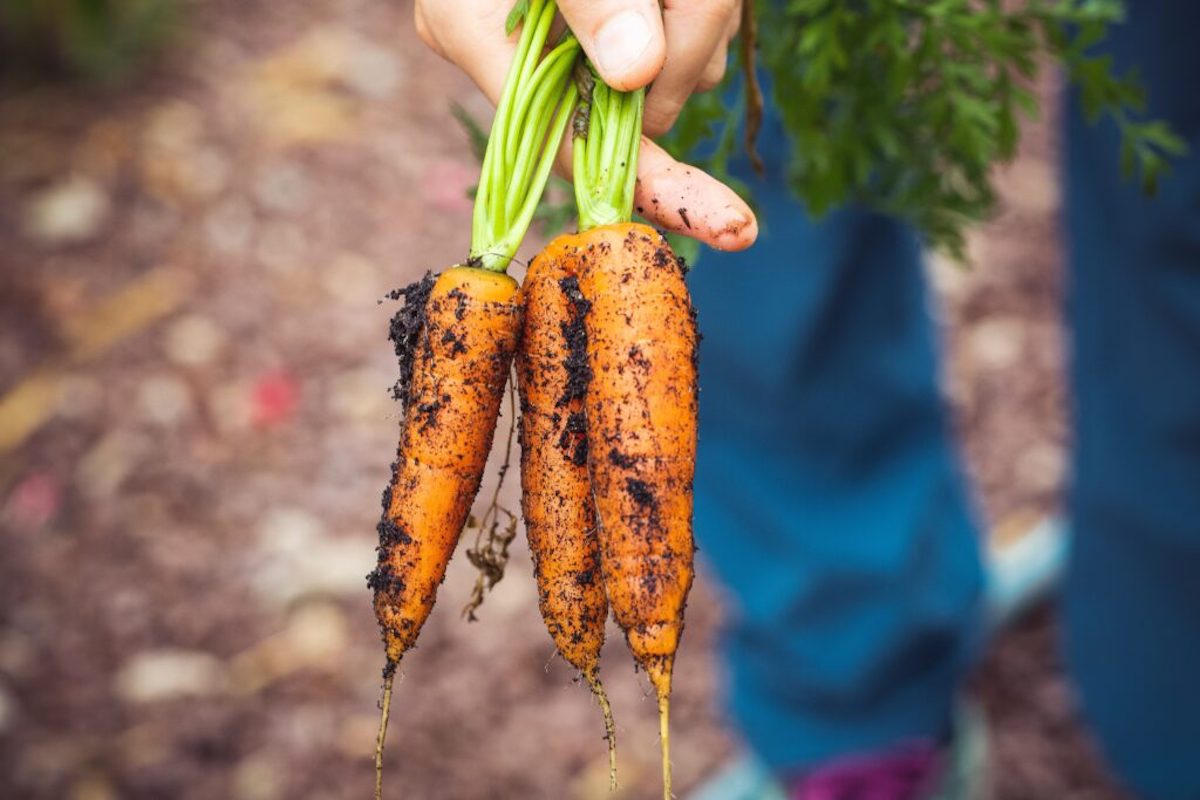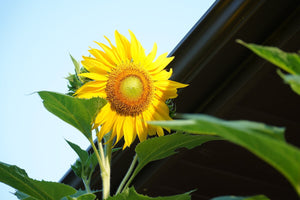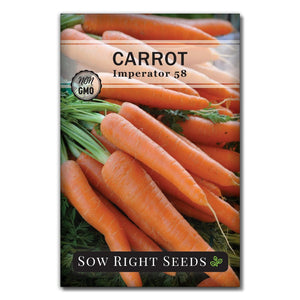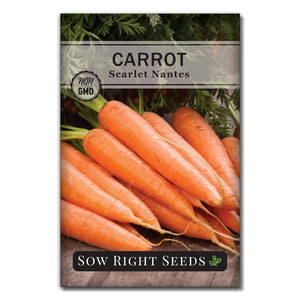How to Grow Carrots: Your seed starting and growing success guide
CarrotsYou already know that carrots are good for your eyes. But did you know they are also good for your immune system, digestion, and blood cholesterol? Eating carrots can also reduce your risk for cancer and benefit your heart.
And did you know that you can grow this delicious vegetable in your own garden? With the right garden soil, carrots are easy to grow from seed. Sow Right Seeds offers a variety of carrots, so you can start growing this healthy vegetable today.

How to Grow Carrots From Seed
Carrots are at the top of the list of favorite vegetables to eat. And it’s no wonder. They are delicious and convenient to eat raw. Carrots are easy to add to a variety of recipes. They also add a ton of nutrition and flavor to juices. So who wouldn’t want to grow this favorite vegetable in their garden?
Our Sow Right Seeds carrot planting guide will cover the carrot growing basics:
Prepare the soil for planting carrots
Preparing the soil ahead of time is vital to grow carrots. Carrots are long root vegetables that need loose, fertile soil that the roots can easily push through. Sandy soil can work well if it has enough organic matter to hold water and nutrients.
For carrots to grow into a nice shape, they need to be able to expand their roots without any impediments. Make sure that the soil does not have rocks or other large materials that will result in deformed roots.
Adding wood ashes a few weeks before planting will add phosphorus while also deterring flea beetles, wireworms, and carrot flies. Well-aged compost is another excellent addition to improve the soil.
Carrots take 14 to 21 days to germinate. Unfortunately, a lot of weeds can grow in that time. So take the time to prepare weed-free soil before planting carrot seeds.
How to Plant Carrot Seeds
Carrots don’t transplant well, so direct sowing is the preferred method for planting carrot seeds.
Carrots are a cool-temperature crop and can be planted directly in the garden about 4 weeks before the last frost date. The seeds can sprout in soil as cool as 45º. However, for faster germination, wait until the ground is at least 50º F.
Plant carrot seeds 1/4” deep and try to space them at least 1 inch apart. Carrot seeds are very small, and this can be difficult. So plan on thinning carrots when they are about 2 inches tall.
Cover the carrot seeds with soil and then add a very thin layer of well-aged compost to help keep the soil moist. Keeping seeds moist at all times is key for good germination.
Here are two tips that will ensure your carrot seeds stay moist and successfully germinate.
1- After sowing the carrot seeds, cover the area with garden fabric that allows water to penetrate and water frequently. This will help keep the seeds moist. Remove the fabric after they germinate.
2 - After sowing and watering the carrot seeds, place a board over the seeds until they start to germinate. The board makes sure the carrots stay in the soil and keeps in the moisture. Remove the board once the seeds have sprouted so the seedlings can receive light and continue to grow.
Carrot seeds will germinate in 14 to 21 days, depending on the temperature of the soil.
Plant carrot seeds every 3 weeks for a continuous harvest. You’ll be tempted to put out the seeds for your whole harvest at once, but unless you want to harvest them all at the same time, succession planting will give you a sustainable harvest to last throughout the growing season.
Carrot Growing Tips
- Once the carrots have sprouted, keep the soil moist with consistent watering.
- Carrot seeds are so tiny it’s hard to space them to their ideal growing distance. So thinning will be necessary.
- When the carrot tops are about 2 inches tall, thin the carrots to 2 inches apart. When thinning carrots, you will want to cut them off instead of pulling them to avoid disturbing the other carrot roots.
- As the carrots grow, they often lose dirt from their tops, and these exposed tops can turn green. You can add more soil or a layer of mulch to keep them from turning green.
- Don’t use fresh manure with carrots as it will cause them to fork and it will affect their taste. (You really don’t want that!)
- Carrots need soil with phosphorus, potassium, calcium, and micronutrients. But they don’t need a lot of nitrogen.
- Keeping the weeds out is important so that the carrots don’t have to compete for nutrients and space.
- And yes, carrots need full sun. So make sure weeds and other plants aren’t shading them out.

Heirloom Carrot Varieties
Imperator 58 Carrot
Imperator 58 Carrot is a long, tapered carrot with a sweet flavor and uniform shape. This reliable heirloom variety grows from 1" to 1.5" in diameter. The mature length for harvesting is between 7" and 9" long. Imperator 58 is always a popular choice for home gardens and market selling.
Kuroda Carrot
For a beautiful deep orange color that is excellent for juicing, grow Kuroda carrots. This Asian heirloom grows 5-8" long and 2" in diameter and is smooth with a stubby wedge shape and blunt tip. Kuroda carrots are more tolerant of heat than most other carrots.
Scarlet Nantes Carrot
Scarlet Nantes Carrots are known for having a very sweet flavor. These heirloom carrots have a bright red-orange, fine-grained brittle flesh and are nearly coreless. The roots of the Scarlet Nantes average 7" long. However, the green tops are short and only grow from 10 to 12" high. This is a nice carrot for pulling up early and eating as baby carrots.
Parisian Carrot
If you want a cute little globe-shaped carrot, try the Parisian Carrot. This sweet-flavored French heirloom dates back to the nineteenth century. The 1-2" round orange roots are resistant to splitting and are ideal for growing in containers or areas with heavy or rocky soils. Parisian carrots can be grown in 10” deep containers.
Rainbow Mix Carrot
Rainbow Mix Carrots come in a blend of rainbow colors--purple, red, white, yellow, and orange. This mix includes Atomic Red, Cosmic Purple, Lunar White, Solar Yellow, and Bambino. These sweet and crunchy heirloom carrots are easy to grow and are perfect for growing in a children’s garden, vegetable gardens, raised beds, and containers.
Solutions for carrot pests and diseases
Adding wood ashes to the garden soil before planting is a natural way to deter wireworms and carrot flies.
Raised beds help prevent carrot rust fly. These flies have a maximum flying altitude of about 12”.
Companion planting with garlic, chives, and leeks will also help drive away flies.
Rotating crops will help avoid diseases. Allow two seasons to pass before planting carrots in the same garden spot.

Harvesting Carrots
Around 70 to 100 days from planting, carrots will be ready to harvest. As you can see, that’s a wide range of time. You can pull up carrots anytime they are the size you want to eat. Smaller carrots will have a different taste than those allowed to grow bigger. Carrots left in the ground too long can become fibrous and tough.
To check the size of your carrots and see if they’re ready to harvest, you can wipe away the dirt from the carrot tops. Most gardeners like to harvest carrots when the tops are 1/2 to 3/4 inch in diameter.
To get carrots out of the ground, you can pull them while twisting. If they’re really stuck, you can use a trowel to dig them up.
Once they are out of the ground, you can wipe off the dirt or let it dry and then brush it off. Don’t wash the carrots with water until you are ready to use them.
Carrots can be stored in the fridge in loosely wrapped plastic bags.
Carrots planted in late summer and fall can be left in the ground after the first frost. In fact, they will even be a little sweeter from the cold. A 4” layer of light mulch, like straw, can help keep the ground warm if you want to prolong the growing season.

Eating Healthy Carrots
Carrots are so delicious and can be used in a variety of recipes, from sweet to savory. You could even have a whole meal with carrots. Start with a raw carrot appetizer followed by a carrot salad, a hearty stew with carrots, and finish off with a slice of carrot cake for dessert.
Think of all the vitamins A, K, and C you will be getting. Carrots are also a sweet way to add extra fiber.
You can be a successful gardener by following these tips on how to grow carrots from seed. So get your garden ready and add this healthy, versatile vegetable. Preparing your soil for carrots will make all the difference. Then plant a new row of seeds every three weeks to have enough carrots for juicing, shredding, slicing, pickling, and freezing. You’re going to love all the ways you can eat delicious, fresh carrots.
Written by Beverly Laudie









Leave a comment